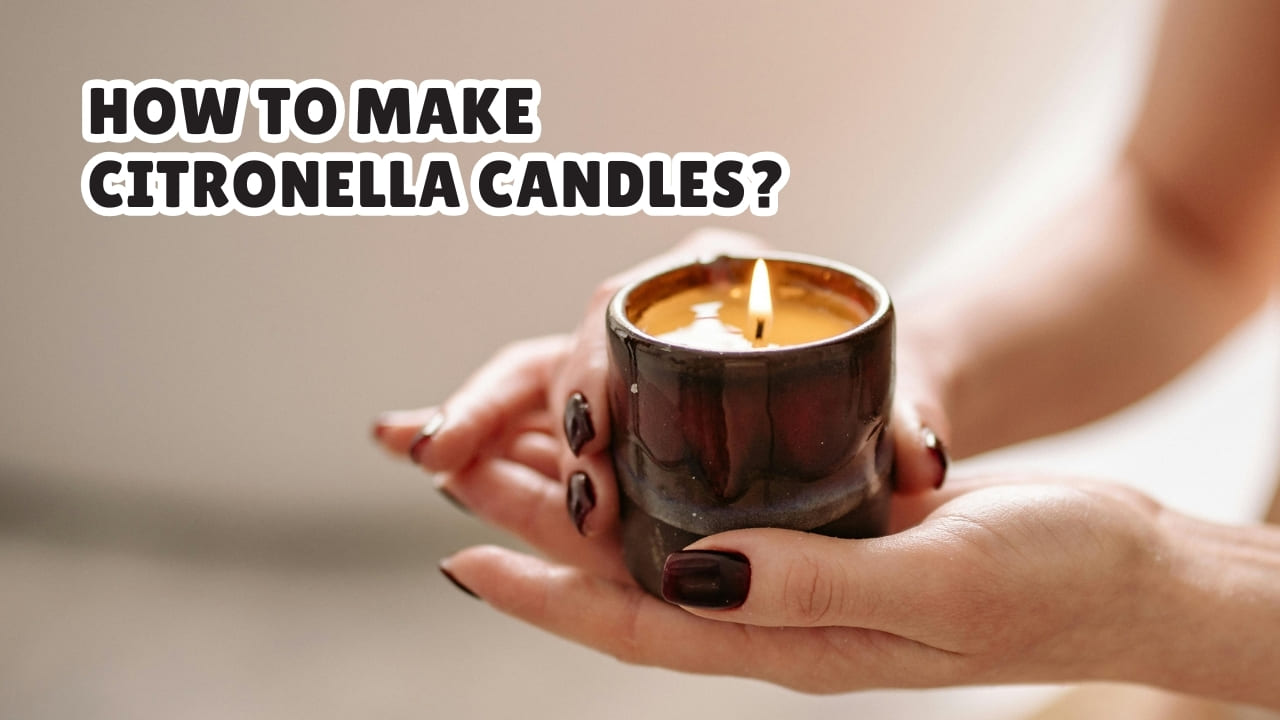Natural Citronella oil candles for repelling mosquitoes
Eco-friendly citronella candles are excellent at keeping mosquitoes at bay and adding beauty to your outdoors. The burning of natural non toxic citronella candles releases no toxins into the environment as soy wax or beeswax are used to make them. These candles contain citronella oil which which is obtained from lemon grass and is effective in driving away insects making it ideal for outdoor parties.
Not only are these candles aesthetically pleasing but when paired with a cotton or wooden wick and put in heat resistant containers, they truly complete the aesthetic while having real life applications. Choosing to make or use these candles allows you to have bug free nights while being eco-friendly!
Introduction to Citronella oil candle making | Making Citronella candles
Citronella candles are undoubtedly an effective way of keeping all sorts of flying and buzzing insects at bay. Apart from the sweet fragrance they let out, they form a sort of “defensive” layer against bugs hence making them perfect for outdoor events. This guide is designed to be a step-by-step approach that will help you develop your own citronella candles at home, starting from materials down to the tiniest details.
Benefits of Citronella oil candles
Before getting into the step by step procedure, it is important to first seek understanding of the reasons as to why citronella candles are commonly preferred when repelling insects:
- Natural Ingredients: Unlike chemical repellents, which can be harmful to one’s health, citronella oil is derived from lemongrass and can be classified as a safe natural oil.
- Pleasant Aroma: Citronella can improve the atmosphere of outdoor places as it has a sufficiently strong citrus smell.
- Eco-Friendly: Environmentally friendly candles can be made from used materials which reduces waste.
Homemade Citronella oil candles
Citronella oil candles can also be made using all natural ingredients in a convenient and an eco-friendly manner. Instead of using unhealthy commercial insect repellents, these candles can be made at home with simple ingredients and they are completely safe to use. The best part about making these candles at home is that they can be made entirely fresh thereby avoiding toxic fillers prevalent in the store bought candles.
How to make Citronella candles? | DIY Citronella candles
Citronella candle ingredients | Materials needed for making Citronella candles
Here is what you will require to make your own citronella candles:
Essential Ingredients
- Wax:
- Soy Wax: A clean fuel option which makes it a popular candle-making wax. It is fully biodegradable, as it comes from soybeans.
- Beeswax: A type of natural wax. Its advantage is that it lasts longer and has a mild sweet scent.
- Paraffin Wax: Collected from petroleum and used in commercial candles. It has the ability to burn but is not as friendly to the environment.
- Citronella Oil:
- It is the most essential component for keeping mosquitoes at bay. Pure Citronella essential oil or specific formulations that include other useful oils like lemon or eucalyptus essential oil can be used as well.
- Wicks:
- It is recommended to use pre-waxed wicks to enhance the stability of the material. Depending on the size of your candle, there are a number of wicks that can be added to the candle, larger ones may utilize numerous wicks for an even burn.
- Containers:
- Poured wax should be placed in durable containers like glass jars, metal tins, and candle holders.
Additional Materials
- Double Boiler: This is meant for melting the wax in a safe way.
- Stirring Utensil: Mix a wooden spoon or stick with it.
- Hot Glue Gun (optional): To position wicks on the wax if necessary.
- Thermometer: To monitor the temperature of the melted wax (ideally between 130°F and 150°F before adding essential oils).
DIY Citronella candles | Step-by-step process for making Citronella candles
Step 1: Prepare Your Workspace
Arrange the workspace in a place that is well ventilated. Put newspapers or extra packaging where you would think spills could happen to avoid any mess. All materials should be nearby and prepared.
Step 2: Prepare the Containers
Select jars with respect to the look of the jar as well as the size that you require. For washed jars make sure they are dry as well.
- In the case of glass jars, suggest giving them a more slightly warm water wash otherwise the pouring will be difficult.
- Place a glue dot or hot glue at the bottom of the jar, and stick a wick cutting across its center vertically.
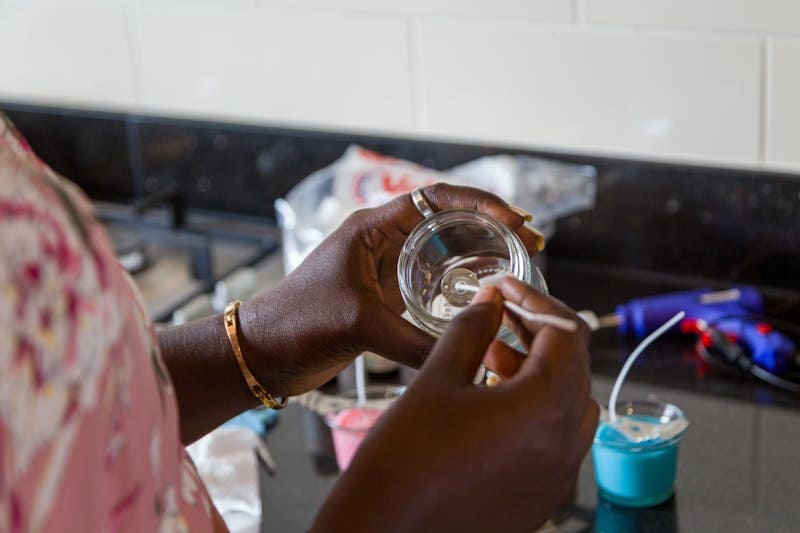
Image Credit: Ed Nollan (Pexels)
Step 3: Melt the Wax
With the aid of a double boiler:
- Take the first pot and add water to it, but do not let it boil instead bring it to a simmer.
- In your upper pot, extract wax of your choice and place it inside the pot, mix it up as required until it completely melts and has a smooth texture to it.

Image Credit: Vlada Karpovich (Pexels)
Step 4: Pour in the Citronella Oil
After the wax has melted:
- Remove the pot from direct heat and let the heat dissipate till it reaches a temperature of 140°F or 60°C.
- Add in about 1 ounce of citronella oil per pound of wax inside the pot, however feel free to adjust it to your liking then give it a proper mix so that the citronella oil is evenly distributed throughout the mixture.
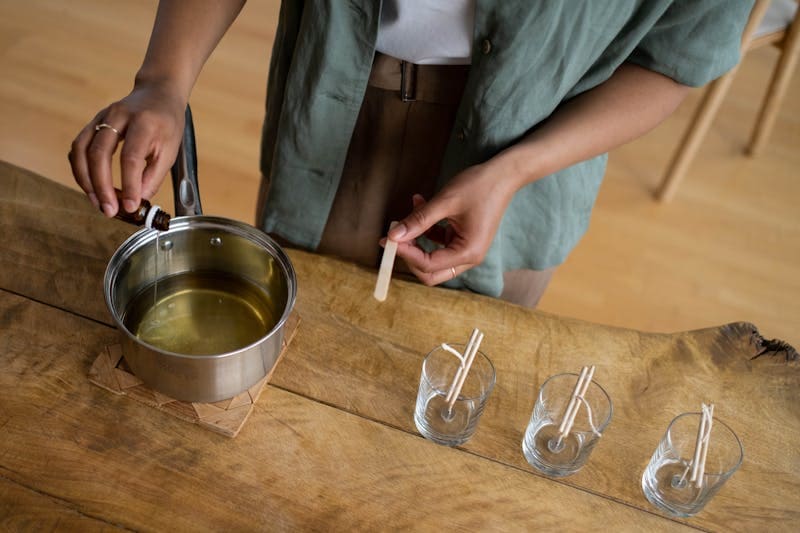
Image Credit: Ron Lach (Pexels)
Step 5: Add In the Wax
Pour the wax that you just made into the molds that you prepared in clear and steady movements.
- When pouring, do not fill the mold all the way to the top, leave a little bit of space for the wax to expand.
- When pouring in the wax, hold onto the wick cutting through the air to prevent it from splashing around inside the mold.

Image Credit: Ron Lach (Pexels)
Step 6: Secure the Wick
In order to keep the wick centered while the wax sits tight:
- Place chopsticks or pencils at the top of the container in a position that lowers the wick in the center.
- Let the candle stand as is till it cools down for several hours, this also ensures that the candle is solidified properly.
Step 7: Trim the Wick
When the candle has cooled down completely:
- Cut a part of the candle’s surface which is ¼ inch above the wick.
- This helps the candles burn evenly.
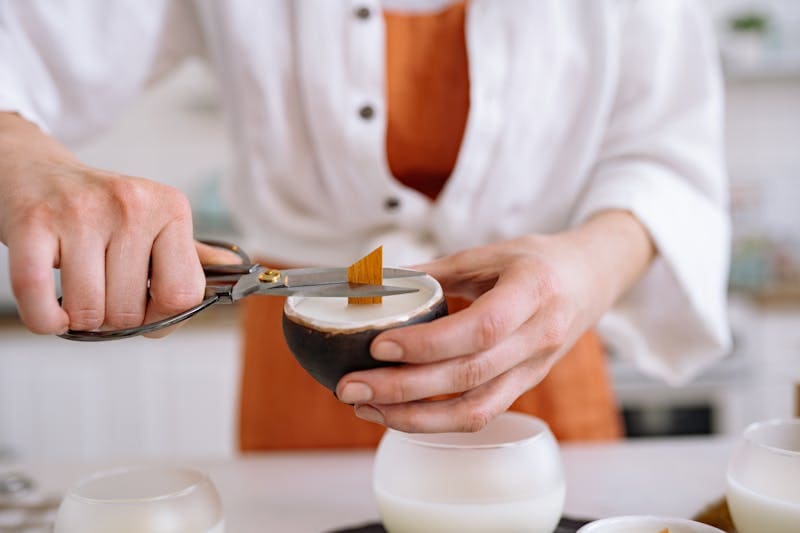
Image Credit: Yan Krukau (Pexels)
Step 8: Cure Your Candles (Optional)
You should allow your candles to cure for a few days before you decide to utilize them. This is to let the fragrances mix and enhances the performance.
Best Citronella oil for candle making
For repelling insects with the aid of candles, citronella oil is one of the most significant and popular oils as it is quite pungent and provides a strong odor to the candles. Oil extracted from the lemongrass’s stems and leaves contains compounds that conceal the carbon dioxide and lactic acid released through human skin which attracts mosquitoes.
With this effect, citronella oil has been popularized in social gatherings during the summers as it gives a good fragrance while keeping mosquitoes away, thus making it a good repelling agent.
However, to make the right selection, it is best that you look for high-quality pure essential oils that have been marked for purchase and use in candles only. Brands that sell citronella oil that is 100% natural and free from any sort of synthetic additives, will allow for a better and a greater smoke free experience.
Other options recommended are those that have a good performance in soy wax or beeswax as these make better perfumed candles that quickly fill the atmosphere with fragrance and have a long burn time. Do your due diligence by researching the product reviews and sourcing details to make sure you get the product that is effective for you.
Additional Tips for making Citronella Candles
- Experiment with Scents: Citronella works on its own, but consider essential oils like lavender, eucalyptus, or peppermint if you want to mix things up a bit.
- Use Quality Ingredients: Your essential oils and wax whatever you are using is of topmost importance and shouldn’t be compromised upon.
- Safety First: Do not leave candles unattended as well as keep them away from combustible substances.
Citronella candle wicks
Citronella candles may require you to make a careful selection of wicks for an efficient wick. Citronella candle wicks are designed specifically for almost non-sooting, non-smoking burning with cotton or wood materials. If you’re looking to use natural waxes such as soy or beeswax then it is recommended you make use of ECO wicks which consist of flat core free braided cotton interlaced with paper filaments offering a good burning experience.
There are other wicks however, which are wooden, and these have a different appeal altogether as they provide a crackling sound when lit and burn well.
But then again, choosing the right wick size and type depends on the diameter and type of wax used and is very important to provide a smooth burn and maximize the efficacy of the insect repelling properties of the citronella oil.

Image Credit: Anna Shvets (Pexels)
How Citronella candle sticks differ from citronella candles?
Citronella candle sticks are fundamentally different from the usual citronella candles largely because of their construction and use. Citronella candle sticks are generally higher and thinner, having the shape of a traditional candlestick, thus they can be used in decorative arrangements or holders. Because of this design, they are often better suited for outdoor use where they can be planted into the ground or placed in holders raising it from the ground, thus making the candle stick give off more light and scent.
On the other hand, the common citronella candles can be found in jars, buckets or jars and made flat such that they can rest on the surface.
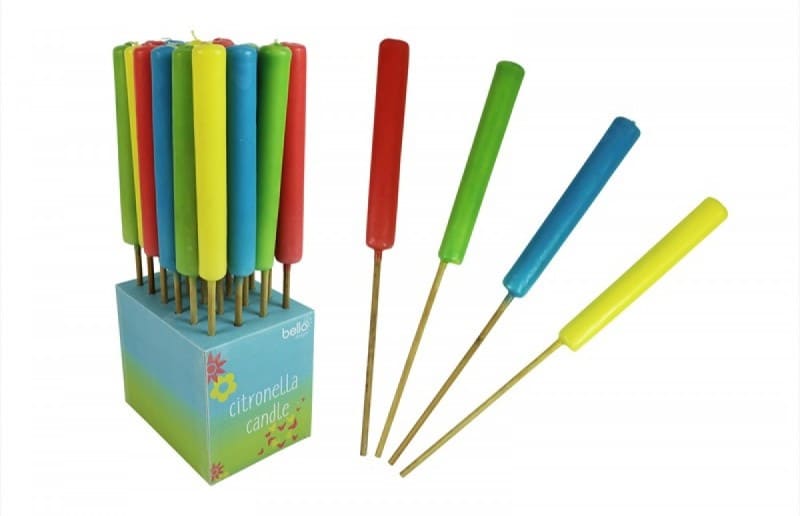
Image Credit: RSW International
In addition, the candle sticks shape say differently about their burning and flame, as they are relatively longer and therefore they manage to repel more insects at outdoor gatherings. Wider candles burn out very fast but are not suitable as they do not keep away insects for that long, but slimmer candles last longer and can burn more often allowing one to have greater effect at any outdoor event.
It’s significantly needless to say that both candles repel insects due to the active chemical of citronella oil, then the question of concern resolves of why anyone would pick one over the other, well this depends on other factors such as the occasion and how much outdoor space is available.
Citronella candle Torch | How efficient are Citronella candle torches as compared to Citronella candles?
Thanks to their design and operational use, citronella torches are more efficient at repelling mosquitoes than citronella candles. Unlike citronella candles that are placed on the ground and have a rather restricted scent range, torches are elevated making it possible for more airflow and wider range of the citronella oil. This also centers around the fact that the insect-repelling fragrance has more reach and the flames enhance the aesthetic of the place more when placed in an elevated position.
Also, torches have a bigger fuel tank which means they can burn longer and protect all night the duration of an outdoor event. Hence overall, it can be concluded that torches are a pretty good option for people that want to spend time outdoors while efficiently keeping mosquitos at bay.
Citronella candles & torches
Citronella torches and candles are effective and fashionable ways of keeping away mosquitoes and other annoying insects when having outdoor activities. While candles might offer a gentle glow in the dark, torches can also be used for extending the reach of the citronella repellent. Both options make good use of the natural scent of citronella oil making it ideal for patios and backyards and even camping out. Having both options allows you to spice up the outdoor set up while keeping off the insects.
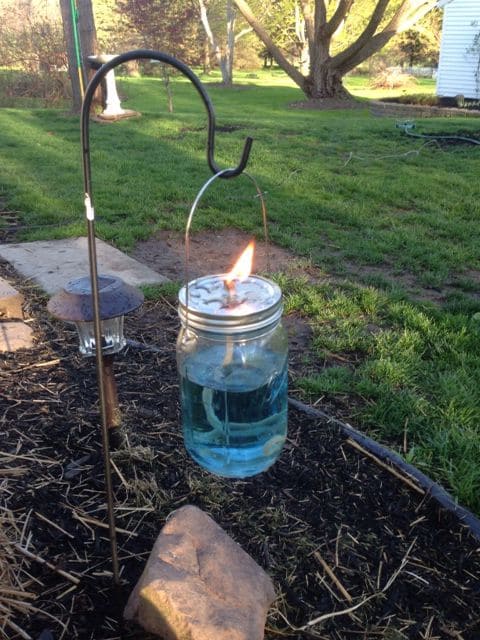
Image Credit: Pinterest, Molly McCarthy
How efficient are Citronella candle bucket?
The buckets of citronella candle are ideal for the repulsion of mosquitoes during outdoor activities while at the same time appears to be more stylish since it is wide. These bucket style candles arm the user with larger amount of wax and citronella oil which increases the release of the repelling scent further multiplying its effectiveness in the process.
The size of the buckets also means that there is a bigger pool of melted wax and hence at the same time there is a increased evaporation of citronella oil allowing it to be more stronger than other versions like the normal candle version. But at the same time, I must emphasize that even though Citronella candles do reduce occurrence of mosquitoes and potentially repels them, they shouldn’t be the only type of protective measure that you use alone.

Citronella candles for camping
What makes camping even better is using camping citronella candles which are a must have for your camping trips in order to stay bug free. The scent of these candles comes from citronella oil and it does a fantastic job at suppressing the smell mosquitoes are attracted to – making your trip a lot more enjoyable. Plus, they are compact which means you can easily bring them with you and light them while you are at the campsite, allowing you to sit back and relax without being bothered by insect bites.
Furthermore, many camping citronella candles are built to burn longer while being able to endure outdoor conditions which can guarantee that your area while camping is bug free.
📰 Must Read,
✔️ What Essential Oils can we Use for Mosquito Bites?
✔️ Backyard Mosquito Treatment: Essential Tips for Homeowners
Conclusion
Natural citronella candles are especially useful for warding off mosquitoes as well as improving your outdoor areas. Various types of wax such as beeswax which offers a clean burn can also be a perfect complement to the honey scent of the citronella. When making homemade citronella oil candles always use the best quality of citronella oil and the pre-waxed wicks. This will ensure a steady and effective burn. If you love camping, camping citronella candles can be made in tin cans or mason jars so it’s portable and you can use it the campsite easily.
While traditional candle forms remain important, creating citronella candle sticks and citronella candle torches allows more flexibility. These not only look nice, but also prolong the burning period and thus are good for outdoor events. For a different touch, you can make a lavender citronella candle, so that the relaxing effect of lavender scent is present with the insect repelling effects of citronella.
In terms of sourcing materials, you would like to create non-toxic citronella candles which makes it recommendable to use natural waxes and essential oils for a more safer burning experience for your guests. Be it a citronella candle bucket for larger events or smaller decorative ones, these candles are a good option and eco friendly in preventing insects while outdoors.
Frequently Asked Questions (FAQs)
-
Can I use citronella candles indoors?
While citronella candles can be used indoors, it is advisable to use them only outside due to the risk of triggering an asthmatic response. While properly utilized, burning citronella candles is rather safe for humans, however, they do tend to produce a fair amount of smoke compared to other scented candles – this feature may prove problematic for those with allergies or for household pets. You could say that there are certain guidelines that you have to adhere to when you are using a candle, it could be as simple as the duration of how long you intend to light the candle for or whether it is kept far from other combustibles.
-
Why can’t you light citronella candles indoors?
The smoke that is emitted from the burning of citronella candles while indoors can be bad for the air quality which may cause some trouble to people who have sensitivities. The other concern is the smell, the amount of citronella smell in a closed space can be large and uncomfortable to some pets. They are not toxic to the body but the burning of citronella candles indoors has great potential to cause smoke related issues which is why it is crucial to use them cautiously.
-
Are there any safety precautions I should take when making citronella candles?
While crafting these candles, it’s essential to keep in mind that all the necessary precautions are taken in order to reduce the chances of an unfortunate incident. Hence, it is important to avoid overheating the wax as it could pose a threat. Moreover, ensure that the space being used is well ventilated otherwise it could be dangerous.
For the burning phase of the candle, heat-resistant containers and strong wicks must be utilized in order to remain safe. Children and pets should be kept away from all the materials as well. Gloves on the hands is an option to keep in mind as when making the candles, the hot wax or oils may hurt the skin.
-
What is the best type of citronella oil to use for candles?
The most effective type of citronella oil for candles is essential oil extracted from Cymbopogon nardus or Cymbopogon winterianus as these variants are known to have the strongest effects of repelling insects. Avoid using any synthetic or filler’s content, instead opt to use pure natural 100 percent citronella oil, as this oil aids in stronger insect repulsion. Additionally, make sure you check the specifications of the oil to be able to use that particular oil for candle making purposes.
-
What is the best way to store citronella candles to maintain their effectiveness
It is suggested that to reduce heat and avoid continual exposure to sunlight, place your citronella candles in dimly lit locations. Heat and light can deteriorate the quality of the essential oils as well as the wax leading to the candles losing effectiveness over a period of time. It is a good idea to keep them covered in airtight containers of some kind preferably of their original packaging so that dust does not settle and affect the fragrance until the candles are put to use.
-
What are the benefits of using beeswax over soy wax for citronella candles?
In contrast to soy wax, there are multiple benefits that beeswax has to offer when it comes to making Citronella candles. Beeswax has a longer and cleaner offering when compared with soy wax as the former produces lesser soot and smoke which is ideal for indoor sessions. Moreover, beeswax is also known for its anti-bacterial properties and the release of negative ions useful in air purification.
It turns out to be a perfect match as it blends nicely with citronella oil. And as a bonus, because beeswax is readily available since it comes from beehives, it serves as a more environmentally friendly alternative.
-
How long does the citronella scent last in a candle?
The time a citronella candle lasts depends on different variables such its composition, such as the type of wax, concentration of oil, and size of the candle. Put simply, most of the outdoor candles, ranging from 20 to 40 hour in burn time (depending on size and formulation), have a fragrance that lasts for several hours. Most importantly, as environmental factors change and the candle shortens, the scent that emanates from it is bound to become less concentrated than during the initial period.
-
Can I add other natural ingredients to enhance the candle’s effectiveness?
Of course, other natural ingredients can be poured into the mixture to enhance the effectiveness of the candle further. Adding additional oils such as eucalyptus, lavender, or peppermint can help in increasing the scents as well as helping repel insects. Rosemary or dried citrus peels can be used along with the target scent of the candle to further enhance the texture and aroma and make it more appealing for those using it.
-
What are the best essential oils to combine with citronella for enhanced mosquito repellency?
The best essential oils to combine with citronella for enhanced mosquito repellency include eucalyptus oil, which has strong insect-repelling properties, lavender oil which is known for its relaxing capabilities but mostly for deterring mosquitoes, and tea tree oil which is ideal especially against other pests. Mixing these oils with citronella will improve the overall mixture providing strong insect repelling capabilities while offering pleasant smell for use outdoors.
-
What is the ideal concentration of citronella oil in a candle?
For a candle to reach optimal burning balance with strong scent diffusion, the concentration level should be maintained between 5% to 10% depending on the intended use and individuals preferences.
-
How does the melting point of paraffin wax affect the candle’s performance?
The melting point for paraffin wax is estimated to be between 120 F to 160F which enables it to perform at standard room temperatures Accordingly, a decrease in melting point will cause the candle to burn off quickly while a increase in melting point will result in slower burn with more scent and aroma. Most importantly, knowing about how these parameters affect the overall burning and scent release of the candle is essential during the making and formulating of these products.

